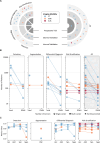This is a preprint.
Artificial Intelligence in Pancreatic Intraductal Papillary Mucinous Neoplasm Imaging: A Systematic Review
- PMID: 39830259
- PMCID: PMC11741484
- DOI: 10.1101/2025.01.08.25320130
Artificial Intelligence in Pancreatic Intraductal Papillary Mucinous Neoplasm Imaging: A Systematic Review
Update in
-
Artificial intelligence in pancreatic intraductal papillary mucinous neoplasm imaging: A systematic review.PLOS Digit Health. 2025 Jul 23;4(7):e0000920. doi: 10.1371/journal.pdig.0000920. eCollection 2025 Jul. PLOS Digit Health. 2025. PMID: 40700385 Free PMC article.
Abstract
Background: Based on the Fukuoka and Kyoto international consensus guidelines, the current clinical management of intraductal papillary mucinous neoplasm (IPMN) largely depends on imaging features. While these criteria are highly sensitive in detecting high-risk IPMN, they lack specificity, resulting in surgical overtreatment. Artificial Intelligence (AI)-based medical image analysis has the potential to augment the clinical management of IPMNs by improving diagnostic accuracy.
Methods: Based on a systematic review of the academic literature on AI in IPMN imaging, 1041 publications were identified of which 25 published studies were included in the analysis. The studies were stratified based on prediction target, underlying data type and imaging modality, patient cohort size, and stage of clinical translation and were subsequently analyzed to identify trends and gaps in the field.
Results: Research on AI in IPMN imaging has been increasing in recent years. The majority of studies utilized CT imaging to train computational models. Most studies presented computational models developed on single-center datasets (n=11,44%) and included less than 250 patients (n=18,72%). Methodologically, convolutional neural network (CNN)-based algorithms were most commonly used. Thematically, most studies reported models augmenting differential diagnosis (n=9,36%) or risk stratification (n=10,40%) rather than IPMN detection (n=5,20%) or IPMN segmentation (n=2,8%).
Conclusion: This systematic review provides a comprehensive overview of the research landscape of AI in IPMN imaging. Computational models have potential to enhance the accurate and precise stratification of patients with IPMN. Multicenter collaboration and datasets comprising various modalities are necessary to fully utilize this potential, alongside concerted efforts towards clinical translation.
Keywords: Artificial intelligence; intraductal papillary mucinous neoplasm; medical imaging; pancreatic cysts; pancreatic surgery.
Conflict of interest statement
Competing Interests FRK declares unpaid advisory roles for Perspectum, Inc., Oxford, UK; Radical Healthcare, Inc., San Francisco, CA; and the Surgical Data Science Collective (SDSC), Washington, DC. CMS declares an unpaid advisory role for Perspectum, Inc., Oxford, UK. All other authors declare no competing interests.
Figures



Similar articles
-
Artificial intelligence in pancreatic intraductal papillary mucinous neoplasm imaging: A systematic review.PLOS Digit Health. 2025 Jul 23;4(7):e0000920. doi: 10.1371/journal.pdig.0000920. eCollection 2025 Jul. PLOS Digit Health. 2025. PMID: 40700385 Free PMC article.
-
Application of Artificial Intelligence in Pancreatic Cyst Management: A Systematic Review.Cancers (Basel). 2025 Aug 2;17(15):2558. doi: 10.3390/cancers17152558. Cancers (Basel). 2025. PMID: 40805252 Free PMC article. Review.
-
Association of high-risk stigmata and worrisome features with advanced neoplasia in intraductal papillary mucinous neoplasms (IPMN): A systematic review.Pancreatology. 2024 Feb;24(1):48-61. doi: 10.1016/j.pan.2023.12.002. Epub 2023 Dec 7. Pancreatology. 2024. PMID: 38161091
-
Artificial intelligence for diagnosing exudative age-related macular degeneration.Cochrane Database Syst Rev. 2024 Oct 17;10(10):CD015522. doi: 10.1002/14651858.CD015522.pub2. Cochrane Database Syst Rev. 2024. PMID: 39417312
-
Evaluation of the Fukuoka Consensus Guidelines for intraductal papillary mucinous neoplasms of the pancreas: Results from a systematic review of 1,382 surgically resected patients.Surgery. 2015 Nov;158(5):1192-202. doi: 10.1016/j.surg.2015.03.021. Epub 2015 May 29. Surgery. 2015. PMID: 26032832
References
-
- Siegel RL, Giaquinto AN, Jemal A. Cancer statistics, 2024. CA Cancer J Clin 2024;74:12–49. - PubMed
-
- Quaresma M, Coleman MP, Rachet B. 40-year trends in an index of survival for all cancers combined and survival adjusted for age and sex for each cancer in England and Wales, 1971–2011: a population-based study. Lancet 2015;385:1206–18. - PubMed
-
- Schawkat K, Manning MA, Glickman JN, Mortele KJ. Pancreatic Ductal Adenocarcinoma and Its Variants: Pearls and Perils. Radiographics 2020;40:1219–39. - PubMed
Publication types
Grants and funding
LinkOut - more resources
Full Text Sources
